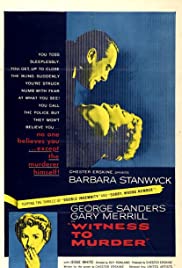
WITNESS TO MURDER
US, 1954, 83 minutes, Black and white.
Barbara Stanwyck, George Sanders, Gary Merrill.
Directed by Roy Rowland.
Witness to Murder would be an episode in later decades of a television series. However, it is an entertaining time filler and thriller, especially with the star power of Barbara Stanwyck and George Sanders.
Barbara Stanwyck portrays a woman who has seen a murder being committed. Nobody will believe her. The murderer, George Sanders, stalks her, tries to persuade the police that she is not competent, eventually tries to kill her. Gary Merrill plays a sympathetic policeman.
While this has all been seen before and since, it is an entertaining pastime thriller.
1. An entertaining crime thriller, psychological?
2. How conventional the material? The style of witnessing the murder, the character of Cheryl Draper?
3. Albert Richter and the conventional Nazi villain? The police? the situations of disbelief, treating Cheryl as mad, the build-up to the climax?
4. Authentic black and white photography, use of darkness and light, shadows? Authentic sets? The strong stress on the musical score and its shrill nature?
5. How credible was the plot? The actual murder, Cheryl’s witnessing of it, the behaviour of the police. her behaviour. Richter's plan? The climax? Sufficient for this kind of melodrama? Is realism absolutely necessary?
6. Barbara Stanwyck's style as Cheryl Draper? The plausibility of her witnessing the murder? calling the police? Her preoccupation with being killed by Richter? her visiting his flat, remarks at work? Her reaction to the letters being written? Her relation to the police especially her reliance on Matthews and falling in love with him? Her experience of being arrested and interrogated, the importance of the experience in the ward and the mad women? Their driving her to suicide ? how plausible? Her having to believe the evidence? Her running up on to scaffolding for the climax? The conventional heroine, suitable for this kind of film?
7. George Sanders as the suave villain? His suave manner with the police, Matthew’s comment on Greeks bearing gifts and therefore his suspicion? His Nazi background, acceptability in America, the fact that the audience knew that he was a murderer? his covering his tracks? Informing the police, typing the letters? His final admission of the truth to Cheryl and the final confrontation? The suitable villain for this kind of film? A credible villain?
8. The portrait of the police and Matthews as an ambitious young man, doing things by the book yet helping Cheryl, falling in love with her? His interrogation scene in the apartment? The building up of suspense? The devices used to show Cheryl’s gradual deterioration and the effect of the madness scenes within this? The build-up to the climax on the roof? Themes of human nature, good and evil, justice?